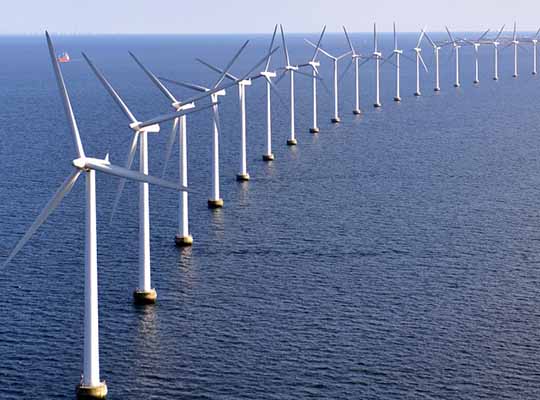NEW YORK – The global Offshore Wind Energy Market accounted for USD 44.8 Billion in 2020 and is expected to reach USD 93.7 Billion by 2028, growing at a CAGR of around 9.1% between 2021 and 2028.
Wind power generation is that the connecting of kinetic energy from the wind and its conversion into electric energy. This is often achieved through the use of wind turbines to get electricity. The energy within the wind turns three propeller-like blades around a rotor. The rotor is connected to the most shaft, which spins the generator to supply electricity. Onshore wind energy has been utilized for several years however, offshore wind energy may be a relatively newer phenomenon.
The rising electricity demand along with quickly increasing emission levels related to traditional power plants is likely to drive the industry growth. A large number of offshore wind energy projects are under the planning and construction phase. Advantages of offshore wind energy installations include an overall reduction in project cost and unhindered primary fuel (wind) required for energy generation since wind speeds are high at offshore than onshore.
COVID-19 Impact Analysis
COVID-19 has impacted businesses across the globe. However, Europe is one among the leading regions in offshore wind energy and one among the foremost severely suffering from the COVID-19, which has restrained the continued growth owing to delays in projects. Following the pandemic, several oil and gas companies around the world have announced job cuts as part of their efforts to reduce expenses. It has further disrupted supply chains, delayed projects on an oilfield, power generation, and created labor shortages. The disruption in European and global trade restricted the project construction, which also resulted in increased CAPEX for the projects. As per IEA, the post-pandemic offshore wind energy market is projected to witness higher growth than the onshore wind market.
Growth Factors
A growing share of renewable energy is predicted to drive the worldwide offshore wind energy market. Increasing awareness about global climate change and technological development is expected to further boost the market. Additionally, the governments of the prevailing offshore markets shall increase their targets and volume towards 2030, which can cause a big increase in offshore installation and therefore the new projects being awarded. However, high-cost risks, and provide chain bottlenecks associated with offshore wind energy projects are expected to hamper the expansion of the market.
Segment Analysis Preview
The global offshore wind energy market is segmented based on foundation type and water depth. Based on water depth, the worldwide offshore wind energy market is segmented into shallow and deep water. Currently, most of the offshore wind energy projects are based in shallow water. Constructing a shallow water offshore wind park incurs lesser efforts and overall project cost. Though, the share of deepwater offshore wind energy projects is projected to extend during the forecast period. Most of the offshore wind energy projects across the world are constructed during a water depth of up to 40 meters. However, many plans are being administered to construct wind farms in water depths of quite 50 meters.
On the essential foundation type, the global offshore wind energy market is segmented into monopile, jacket, tripod, and floating. Monopile foundations held the leading share of the worldwide wind energy market. These sorts of foundations are easy to construct and comparatively cheaper than other types. However, monopolies aren’t fitted to deepwater projects. During the forecast period, floating-type foundations are expected to grow at the fastest rate. Offshore floating foundations are advantageous over fixed structures in terms of the entire cost incurred in installation and production. On the opposite hand, traditional offshore plants need fixing of foundations to the seafloor and bolting of massive turbines on them, which may hamper the ecology also.
Regional Analysis Preview
Europe dominated the worldwide offshore wind energy market in 2016. Countries like the U.K., Germany, Denmark, Netherlands, Belgium, and Sweden among others are leading players in Europe’s offshore wind energy market. The Asia Pacific followed Europe in terms of offshore wind energy cumulative installed capacity. China is that the leading player in Asia Pacific offshore wind energy market and is predicted to grow at the fastest rate across the world. Japan, South Korea, and India among others are expected to further boost the market during the forecast period. The U.S. is additionally expected to witness numerous offshore wind energy projects during the forecast period. Other countries including Finland, Ireland, Spain, Norway, and Portugal also are expected to spice up the worldwide offshore wind energy market during the forecast period.
Key Market Players & Competitive Landscape
The major players that are comprised in Offshore Wind Energy Market are Northland Power, Enercon GmbH, Siemens Wind Power, Gamesa Corporacion Technologica S.A., Guodian United Power Technology Company Ltd, Nordex S.E., Vestas Wind Systems A/S, Upwind Solutions Inc., Suzlon Group, Xinjiang Goldwind Science & Technologies Co. Ltd, GE Wind Energy, China Ming Yang Wind Power, Dong Energy, and Sinovel among others.
The global Offshore Wind Energy Market is segmented as follows:
By Foundation Type
- Monopile
- Jacket
- Tripod
- Floating
By Water Type
- Shallow Water
- Deep Water
By Region
- North America
- The U.S.
- Canada
- Europe
- France
- The UK
- Spain
- Germany
- Italy
- Rest of Europe
- Asia Pacific
- China
- Japan
- India
- South Korea
- Southeast Asia
- Rest of Asia Pacific
- Latin America
- Brazil
- Mexico
- Rest of Latin America
- Middle East & Africa
- GCC
- South Africa
- Rest of Middle East & Africa
For more information, please visit : www.zionmarketresearch.com













